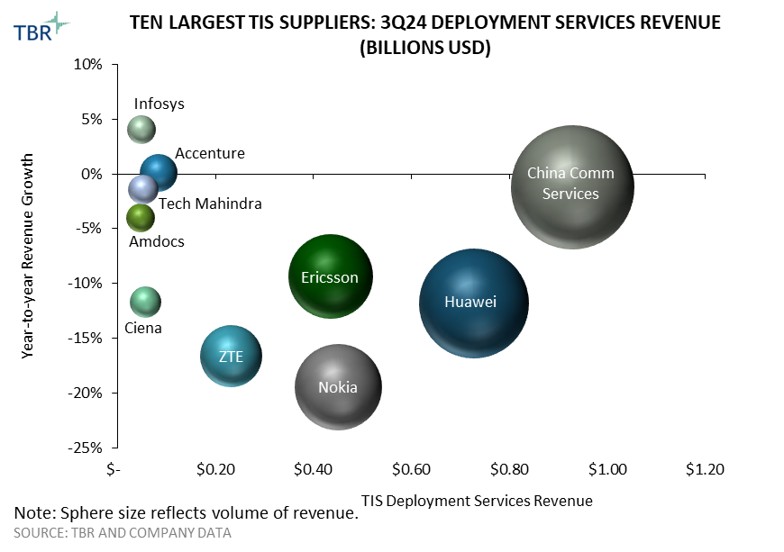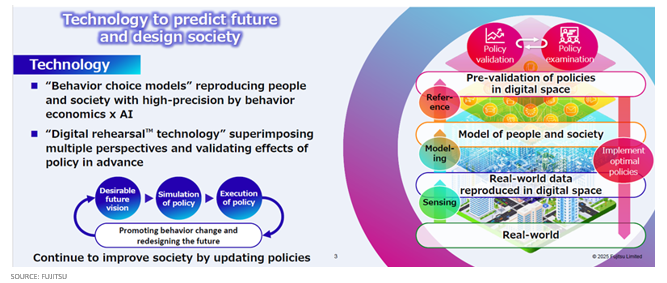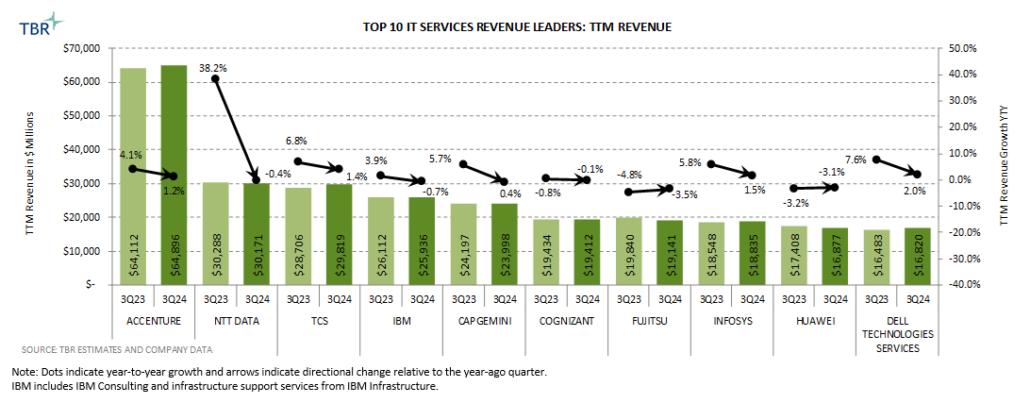Leading Federal Systems Integrators React to U.S. Department of Government Efficiency
After a four-year bull market featuring unprecedented spending growth in federal IT, DOGE is creating near-term challenges for FSIs
The newly inaugurated Trump administration and its Department of Government Efficiency (DOGE) have generated massive upheaval across the board in federal operations, including the federal IT segment. As of March 2025, thousands of contracts described by DOGE as “non-mission critical” have been canceled, including some across the federal IT and professional services landscape.
The initial contract terminations have fallen disproportionately on smaller-scale programs, many of which were held by small service-disabled veteran-owned vendors, though leading federal systems integrators (FSIs) have not been spared as some large-scale programs have also been canceled. For example, federal IT leader Leidos had a $1.5 billion award with the Social Security Administration (SSA) for systems operations and hardware engineering scaled back significantly in February 2025.
There is no question that the federal government must enhance efficiencies and use IT to enable more cost-effective operations, as DOGE promises. TBR estimates that federal agencies are collectively spending over $100 billion every year on systems that are often not interoperable and in desperate need of modernization. The initial weeks of the Trump administration and actions of the DOGE advisory board, however, have thrown the federal sector into chaos. Federal IT vendors are scrambling to adjust their strategies and tactics to align with the market, which is quickly shifting under their feet.
However, the lack of clarity from DOGE as to how it is evaluating and will continue to evaluate the merit of federal contracts is making effective strategic planning nearly impossible for federal technology contractors. In this special report, we summarize how the FSIs we track are reacting to the emerging DOGE-driven challenges and how well they are positioned to not only deflect near-term disruptions but also capture future opportunities.
Watch Now: GenAI in Federal IT Services in 2025, featuring TBR analysts John Caucis and James Wichert
Accenture Federal Services (AFS)
Strengths and Opportunities
AFS’ core competencies are well aligned with DOGE’s focus on driving efficiencies: broad-based investments in cloud, generative AI (GenAI), innovation and showcase facilities; tight management of their alliance ecosystem; and prudent acquisitions that have been quickly and effectively integrated. AFS has been using AI simulations over the last couple of years that incorporate economic modeling and statistical analysis of federal budgets to show federal leaders new ways to reimagine public resource allocation based on economic modeling and federal budget analysis.
Weaknesses, Risks and Areas Exposed to Market Turmoil
AFS is one of the 10 or so consulting-led FSIs that will be particularly under close scrutiny by the DOGE advisory board and the Trump administration and could consequently see several of its ongoing strategic engagements scaled back. AFS tends to leverage premium pricing as part of its consulting-led go-to-market approach. The vendor lacks the operational scale and multibillion-dollar engagements of its larger FSI peers, limiting its ability to absorb marketwide disruptions.
How will AFS respond to DOGE?
AFS will emphasize the security of its offerings and the vendor’s ability to generate efficiencies for federal agencies, doubling down on its 2024 go-to-market messaging that stressed cybersecurity as core to its digital transformation strategy. AFS will also emphasize its use of cloud, data and AI to drive enhanced efficiencies, and the company believes there will be an even greater appetite for adopting commercial solutions stemming from DOGE’s recommendations. We expect AFS to leverage its corporate parent more heavily than ever to gain access to expertise, case studies and best practices, and the latest digital technologies that have been refined in commercial environments.
Booz Allen Hamilton (BAH)
Strengths and Opportunities
BAH will draft off the unprecedented success of its three-year strategic growth initiative VoLT (Velocity, Leadership and Technology), which ran from the company’s FY23 through FY25 (ending March 31, 2025). The VoLT program generated three straight years of double-digit growth, including multiyear, 20%-plus growth in the lucrative federal health IT market. VoLT also delivered record profits and profit margins and robust cash flows (potentially $900 million-plus in free cash flow in FY25, up from $192 million in FY24 and $527 million in FY23) that can be plowed back into the business. BAH is also well diversified across the civil, Department of Defense (DOD) and Intelligence Community (IC) markets and has over a century of experience in the federal market. BAH sees DOGE as a shift in priorities, not an across-the-board cost takeout.
Weaknesses, Risks and Areas Exposed to Market Turmoil
Like AFS, BAH will be highly exposed to precipitous cuts in federal budget outlays for consulting services, but BAH’s exposure could be in the billions of dollars, the highest across the FSI landscape. BAH also tends to demand a premium for its advisory services and could face significant price-based competition from smaller advisory-focused peers offering similar but discounted consulting services more tightly aligned with DOGE’s core objectives.
How will BAH respond to DOGE?
BAH will tout its experience and successes enhancing efficiencies while crafting strategies for agencies to reinvest savings from DOGE-driven budget cuts, and the eventual implementation of the most cost-effective IT-based solutions, in next-generation technologies to support future missions. The vendor will focus on its versatility while building an even more opportunity-focused mindset in its workforce. BAH will adjust its messaging to emphasize its capabilities to deliver innovation at speed within outcome-based contracting arrangements. Stay tuned for BAH’s next three-year growth strategy, expected to be unveiled in the early months of the firm’s FY26, for more details on how DOGE will impact federal IT’s most venerable firm.
CACI
Strengths and Opportunities
CACI generates 75% of revenue from the DOD and IC, which could shield the company from contract cancellations or revenue contraction if DOGE’s focus is tilted toward the civilian sector. Civil-focused cuts could generate opportunities for CACI around its extensive suite of AI technologies that enable companies to automate more human-resource-intensive tasks and enhance financial management operations. CACI is already entrenched in DOD- and IC-based modernization efforts and can showcase its success in deploying AI technologies.
Weaknesses, Risks and Areas Exposed to Market Turmoil
While DOD contracts are protested less often than civil awards, that could change with future large-scale DOD contracts in a DOGE-based federal contracting environment. Roughly 60% of CACI’s order book is cost-plus work, which could continue to be the DOD’s preferred price structure for net-new technology, but it appears DOGE could drive a more fixed-price award structure (less than 30% of CACI’s contracts are structured as firm-fixed-price awards). CACI’s footprint in the civil space is limited, and the company could miss out on opportunities if DOGE turns to the civil segment for AI-enhanced automation solutions to replace furloughed government employees.
How will CACI respond to DOGE?
CACI immediately requested meetings with executive-level IT decision makers and contract managers at DOD and IC agencies, encouraging them to ensure optimum speed-to-decision with any DOGE-related actions. CACI does not foresee delays in contract adjudication in the near term; awards in the decision pipeline are now expected to be finalized by the fourth quarter of FFY2025 (federal fiscal year 2025).
From a solutions standpoint, CACI will promote its AI technologies as key to federal acquisition reform and its counter-UAS (unmanned aerial systems) technologies as critical to homeland defense. CACI will highlight successes on its BEAGLE (Border Enforcement Applications for Government Leading Edge IT) program with the Department of Homeland Security (DHS) Customs and Border Protection, and on NASA’s NCAPS (NASA Consolidated Applications and Platform Services) program in pursuit of new civil opportunities.
CGI Federal
Strengths and Opportunities
CGI Federal has been gaining strong traction with its core managed services platforms, Momentum (financial management) and Sunflower (asset management). These offerings not only have enabled the company to be a perennial margin leader in TBR’s Federal IT Services Benchmark but also are well aligned to DOGE’s cost takeout objectives with a track record to prove it. CGI Federal’s managed services offerings have also facilitated deep relationships with the Department of Justice (DOJ) and Treasury Department.
Weaknesses, Risks and Areas Exposed to Market Turmoil
CGI Federal generates roughly 90% of its revenue from the civilian sector and could be overexposed to DOGE-related budget reductions that disproportionately impact civilian agencies. The company has made key strategic acquisitions to bolster its advisory capabilities in recent years (e.g., Array in 4Q21, TeraThink in 1Q20, and Sunflower Systems in 3Q19), but its advisory capabilities lack the maturity, breadth and market reputation of similar services offered by consulting leaders like BAH and AFS. Conversely, CGI Federal could undercut its larger consulting-led peers by offering discounted advisory services that emphasize its core capabilities in enhancing agency fiscal and operations management.
How will CGI Federal respond to DOGE?
CGI Federal was one of the 10 consulting-focused FSIs mentioned in the Trump administration’s Feb. 27 memo demanding that agencies review consulting engagements and cut “non-essential consulting contracts.” The company’s reaction to DOGE has been limited compared to its peers, but we anticipate CGI Federal will tout its automation and AI capabilities, along with its flagship financial and asset management platforms, as having the exact capabilities civilian agencies will need to achieve IT-driven cost reductions.
General Dynamics Technologies (GDT)
Strengths and Opportunities
Demand for General Dynamics Information Technology’s (GDIT) digital accelerators (Comet 5G, Coral Software Factory, Cove AI Operations, Eclipse Defensive Cyber, Ember Digital Engineering, Everest Zero Trust, Hive Hybrid Multi-Cloud, Luna AI and Tidal Post-Quantum Cryptography) has continued to grow, generating nearly $7.5 billion in contract awards in 2024 compared to more than $2 billion in 2023.
Weaknesses, Risks and Areas Exposed to Market Turmoil
While the DOD is still GDT’s largest customer, GDIT’s recent expansion into the federal health market leaves it more vulnerable in the short term as the Trump administration looks to rapidly pull back on spending for agencies like the U.S. Department of Health and Human Services (HHS). Additionally, the General Services Administration (GSA) has indicated that GDIT’s consulting contracts will be closely reviewed going forward.
How will GDT respond to DOGE?
TBR anticipates that GDIT will invest further in its digital accelerator-centric strategy and increasingly collaborate with partners like ServiceNow. This will allow GDIT to expand its capabilities with emerging technologies and support DOGE’s effort to accelerate IT infrastructure modernization.
IBM Consulting
Strengths and Opportunities
IBM Consulting’s federal market group, IBM-Fed*, is two years removed from its strategic acquisition of Octo Consulting and won positions on a handful of large-scale programs with both civilian and defense agencies in 2024, suggesting the company is fully leveraging the added scale and portfolio depth it obtained from Octo.
Weaknesses, Risks and Areas Exposed to Market Turmoil
IBM-Fed, while not entirely a newcomer to the federal IT market, is the smallest of the FSIs tracked in TBR’s Federal IT Services Benchmark. While its smaller scale may limit its exposure to DOGE, the company has ongoing, strategic programs with USAID (United States Agency for International Development) ($95 million, five-year contract for cybersecurity services won in 2023) and U.S. Citizenship and Immigration Services (USCIS) ($279 million, five-year contract won in 2Q24) that are likely at risk.
The cancellation of these programs would severely impact IBM-Fed’s smaller revenue base relative to its FSI peers. The overarching goal of the Octo acquisition was to expand IBM-Fed’s advisory chops; DOGE could derail IBM-Fed’s still nascent efforts to gain ground in the federal IT market as a consulting-focused professional services competitor.
How will IBM Consulting respond to DOGE?
TBR expects IBM-Fed will double down on hybrid cloud and cybersecurity, capabilities at the heart of the company’s burgeoning federal IT growth effort, as DOGE continues upending the federal IT market. IBM-Fed can also leverage hybrid and multicloud capabilities obtained from the now-finalized acquisition of HashiCorp. IBM was one of the companies mentioned in the Trump administration’s Feb. 27 memo regarding federal consulting contracts and the federal government’s use of consultancies.
An IBM spokesperson responded in a Nextgov interview the same day the memo was released, saying, “Today, IBM supports the modernization and delivery of mission critical federal services and systems, from processing veteran health claims more quickly to enabling a more efficient digital taxpayer experience. We are … committed to helping agencies become more efficient and deliver better results for the American public.” IBM’s response was necessary, but still rather boilerplate in its tone and lack of detail. (*TBR refers to IBM Consulting’s federal IT operations as IBM-Fed. IBM-Fed is not an official business line title used by IBM or IBM Consulting. The business defined by TBR as IBM-Fed resides within IBM Consulting’s U.S. Public and Federal Market group.)
Leidos
Strengths and Opportunities
Leidos has the largest scale across federal IT, and the number of multiyear, multibillion-dollar engagements on its books is a testament to not only the company’s ability to deliver agencywide IT transformation but also its strong contract delivery on prior-year engagements. The vendor is well diversified across the federal IT market with large civil, defense and IC practices. Leidos is also diversified geographically, generating between 10% and 15% of its business from international markets, where the company is gaining traction. Its’ international operations could enable the company to withstand short-term turbulence in the federal IT market, at least in terms of its profit and loss statement.
Weaknesses, Risks and Areas Exposed to Market Turmoil
Dynetics, Leidos’ robust and differentiating R&D subsidiary, could be negatively impacted if the Trump administration deemphasizes R&D investments or if DOGE reduces R&D budgets. Leidos also has a large federal health IT business, which could be vulnerable if DOGE targets the health IT market for cost cuts after robust spending under the previous administration. Further, Leidos could face increased protests around its large strategic awards by unsuccessful competitors trying to undercut Leidos on price.
How will Leidos respond to DOGE?
Leidos executives stated during the company’s 4Q24 earnings call that they believe DOGE gives the company “increased confidence in our strategy,” but the details remain scarce. Those details are likely forthcoming, as Leidos will unveil North Star 2030, the company’s growth strategies for the next five years, this summer. We anticipate Leidos will emphasize guiding clients through the elimination of regulations, efforts to streamline procurement, and the shift to more outcome-based contracting.
Leidos will also increasingly emphasize its ability to accelerate ongoing digital transformation programs and tout its strong record of past performance (e.g., its ongoing, $11.5 billion Defense Enclave Services engagement). Leidos will also focus on developing innovative IT-enhanced military capabilities and will likely plow robust cash flows from FY24 into R&D to accelerate the development of market-ready solutions for next-generation warfighting in areas like hypersonics, unmanned systems and ISR (intelligence, surveillance and reconnaissance) systems.
ICF International
Strengths and Opportunities
After spending over $600 million on M&A to rapidly develop its digital modernization business from 2020 through 2022 (ICF’s digitalization business’ annual revenue more than quintupled over this time frame to reach $500 million), ICF started securing more high-profile federal IT contracts worth over $100 million in 2024 while letting low-margin engagements roll off its books.
Weaknesses, Risks and Areas Exposed to Market Turmoil
During ICF’s earnings call, executives warned that the company’s 2025 total revenue could contract by up to 10% compared to 2024. While ICF’s environmental work is particularly vulnerable, its digital modernization business will face disruptions. For example, ICF already was struggling with delays tied to lucrative contracts with USAID before the Trump administration placed the agency in its crosshairs. Additionally, a concentrated push to outcome-based contracting, along with a sharp reduction in agencies’ headcounts, could lead to demand pulling back for ICF’s low-code/no-code platforms.
How will ICF International respond to DOGE?
ICF may shift its focus from supporting the Energy, Environment, Infrastructure and Disaster Recovery client market back to developing its digital modernization business, including building upon its fraud detection capabilities.
Maximus
Strengths and Opportunities
Since acquiring Veterans Evaluation Services for $1.4 billion in 2Q21, Maximus has been capitalizing on the surge in opportunities created by the Honoring Our Promise to Address Comprehensive Toxics (PACT) Act while supporting the Department of Veterans Affairs (VA) on a plethora of medical disability examination (MDE) contracts. Business process outsourcing (BPO) remains at the core of Maximus’ go-to-market strategy as the company parlays these initial engagements where it provides more traditional services into more lucrative opportunities with clients like the IRS.
Weaknesses, Risks and Areas Exposed to Market Turmoil
Maximus has been deepening its relationship with the IRS over the years and in 2023 was named a prime contractor on the $2.6 billion Enterprise Development, Operations Services (EDOS) contract. With the IRS’s 90,000-person workforce expected to be reduced by up to 50% under the Trump administration, future funding could be disrupted and upend Maximus’ efforts to branch out. Similarly, Maximus’ exposure to the VA may become a weakness as the agency’s headcount is expected to be reduced by more than 15% (approximately 80,000 workers) as it comes under greater scrutiny by the Trump administration.
How will Maximus respond to DOGE?
While bipartisan support for the PACT Act should persist and provide Maximus’ federal business with steady income, the company will leverage its IT systems, network infrastructure and software development capabilities in the long term to increase clients’ efficiency.
ManTech
Strengths and Opportunities
Being a private company gives ManTech a competitive advantage compared to its FSI peers as consultancies race against the quarterly earnings clock during this chaotic period. With the financial backing of The Carlyle Group, ManTech is one of the best positioned vendors in TBR’s Federal IT Services Benchmark to make an acquisition. ManTech can take its time refining its digital consulting practice, aligning it with the Trump administration’s long-term priorities and scooping up displaced consultants from players like AFS while building upon the fundamentals of consulting: people and permission.
Weaknesses, Risks and Areas Exposed to Market Turmoil
ManTech has historically been a margin laggard compared to its peers in TBR’s Federal IT Services Benchmark, with the vendor last disclosing an operating margin of 5.2% in 2Q22. While ManTech’s restructuring efforts could bring its operating margin more in line with the competition over time, a prolonged return of the lowest price technically acceptable (LPTA) environment would cause significant harm as ManTech lacks the scale to consistently vie for must-win engagements against Tier 1 peers.
How will ManTech respond to DOGE?
TBR anticipates that ManTech will lean further into opportunities with its core defense and intelligence clients, given DOGE’s crackdown on non-mission-critical spending seems to be concentrated more in the federal civilian sphere. As DOGE hopes to accelerate the modernization of IT infrastructure and apply AI across the agencies, ManTech will continue to identify new ways to weave the emerging technology into their workflows.
Peraton
Strengths and Opportunities
The three-way megamerger with Perspecta and three Northrop Grumman business units expanded Peraton’s sales sevenfold from roughly $1.0 billion in 2020 to between $7.0 billion and $7.2 billion in 2021, according to TBR estimates. Peraton quickly fused these assets into one homogeneous entity and has been using its newfound scale to reliably compete against established leaders in the federal IT industry, such as GDT, across the civilian and defense markets.
Weaknesses, Risks and Areas Exposed to Market Turmoil
While Peraton has been further penetrating the federal civilian and health spaces by leveraging its newfound digital transformation, analytics and lifecycle management capabilities, the years of robust health IT budget growth are unlikely to continue under the Trump administration. Peraton is a prime contractor on the Social Security Administration’s IT Support Service Contract II vehicle, which DOGE recently targeted for cuts.
How will Peraton respond to DOGE?
Veritas Capital is no longer expected to take Peraton public as federal IT vendors’ valuations have cratered from their November 2024 highs. Under CEO Steve Schorer’s guidance, Peraton will accelerate its efforts to harness emerging technologies to better compete for enterprise IT awards in the $500 million to $2 billion range. As agencies appear to be increasingly open to adopting an “as a Service” model, Peraton will continue to position itself as a cloud services broker to win deals like the Cloud Hosting Solutions III contract and shore up its relationships with partners like SoftIron.
SAIC
Strengths and Opportunities
SAIC has scale, a growing suite of partner-enhanced cloud solutions, and a vendor-agnostic approach to migrating federal IT workloads to cloud environments that have enabled the company to improve its fiscal performance and land strategic engagements. The vendor also derives nearly three-quarters of its revenue from the DOD and IC, potentially sheltering the company from DOGE-related budget cuts in the civil space. SAIC is perhaps the foremost prime contractor with the U.S. Air Force (USAF) leading the service branch’s multiyear cloud migration initiatives.
Weaknesses, Risks and Areas Exposed to Market Turmoil
SAIC’s marquee engagements are with civilian agencies, including the seven-year, $1.3 billion T-Cloud program won in 1Q23 with the U.S. Department of the Treasury and the $8 billion blanket purchase agreement with the FBI won in 2Q24, potentially overexposing the company to DOGE-based efforts in the civil sector. The company is also in the middle of an operational and organizational restructuring effort that, while gaining traction, could be undermined by DOGE-related market disruption.
Recent unsuccessful contract renewals and business-line divestitures have generated lingering organic growth headwinds that have caused SAIC’s top-line growth to lag its peers’, and may limit the company’s ability to buffer the impact of DOGE-related contract reductions or terminations on its top line. SAIC’s margin performance is improving but also trails that of larger federal IT peers; DOGE may jeopardize the company’s continued profit elevation.
How will SAIC respond to DOGE?
SAIC will tout its integration expertise and ability to fuse cloud-based products, platforms and solutions from its partners and joint ventures together to create cloud environments for its customers that will generate DOGE-mandated savings. SAIC will repurpose its experience delivering cloud-enhanced, mission-critical solutions for the DOD to accelerate cloud-based growth in the civilian sector in 2025 and 2026, emphasizing cloud infrastructures as the optimal way for civil and defense agencies to drive down operating costs.
CEO Toni Townes-Whitley appeared on Bloomberg TV in early December, saying, “We think we are well positioned” and “Looking forward to that engagement” with DOGE and the Trump administration. She was the first CEO of the FSIs tracked by TBR to respond to the potential impact of the then-incoming Trump administration, smartly getting out in front of the emerging market disruption. Townes-Whitley also noted that SAIC will look at “where are the levers in an environment where technology will be the enabler of efficiencies,” but also said she expects SAIC will have to “adapt to an environment where spending is more circumspect.”
TBR’s Federal IT Services research team will provide additional company-specific analysis of the impact of DOGE and the Trump administration’s proposed budget actions on the FSIs in our upcoming blog series, DOGE Federal IT Vendor Impact, featuring reports and profiles of the contractors mentioned in this special report.
Subscribe to Insights Flight to receive each blog in your inbox as soon as it publishes and to download a preview of our federal IT services vendor benchmark research.




